He's deaf, not dumb!
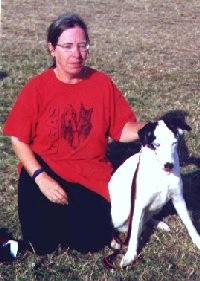 Does
your dog give you the impression that he understands every word you say - or is he deaf to
every command you shout at him? If you have ever watched Lisanne Steen guide her working sheep
dog Merlin around an agility course, you would be surprised to learn that Merlin was born deaf.
He has never heard Lisanne's voice, his pack-mates growls or a squeaky toy. How on earth was he
trained to be a good companion and agility dog? Mary Ann Nester interviews Lisanne. Does
your dog give you the impression that he understands every word you say - or is he deaf to
every command you shout at him? If you have ever watched Lisanne Steen guide her working sheep
dog Merlin around an agility course, you would be surprised to learn that Merlin was born deaf.
He has never heard Lisanne's voice, his pack-mates growls or a squeaky toy. How on earth was he
trained to be a good companion and agility dog? Mary Ann Nester interviews Lisanne.
Hearing is usually well-developed in dogs, and they are
able to hear sounds that are too high pitched or far away for human beings to identify. This
greater range helps them in hunting their prey and communicating with each other. Deaf dogs
like Merlin, never rotate their ears to scan the aural horizon.
Mary Ann: Why did you
chose a deaf puppy?
Lisanne:
I had just had to have my six year old Irish Terrier Brandy put to sleep. Next to his obituary
in Dog Training Weekly was an advert for Merlin. It said he was deaf and needed a home.
It was too terrible to even think that he might be put to sleep because he couldn't hear. He
was nine weeks old when he came to live with me and had two previous foster homes.
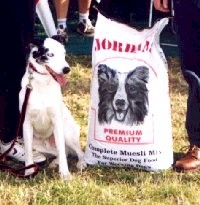 Mary
Ann: Do you know the cause of his deafness? Mary
Ann: Do you know the cause of his deafness?
Lisanne:
No. Although it was obvious that Merlin couldn't hear, my vet recommended I take him to the
Animal Health Trust for tests. Maybe there was some residual hearing in one or both ears.
Perhaps Merlin could detect some of the higher frequencies, and I would train him to a whistle.
I was told that if Merlin had his ear up to a loud speaker at peak decibel at a disco, not a
note would register with him.
Mary Ann: What about the
other puppies in his litter?
Lisanne:
Out of a litter of six miss-marked puppies, one has hearing problems, another is deaf in one
ear, and Merlin is completely deaf.
Mary Ann: Do you have
other dogs, and how did you introduce Merlin to them? Is canine protocol a problem for him? Can
missing a growl lead to serious misunderstandings?
Lisanne:
When I got Merlin, I had eight other dogs. One of Merlin's foster homes had Golden Retrievers
and the other had Springer Spaniels. He was used to being surrounded by lively dogs by the time
he came to live with me. I introduced him to a few dogs at a time. They took it all in their
stride and were probably more tolerant because he was a puppy, not because he was deaf.
 Once,
when Merlin lost sight of me, Flower, my greyhound lost her patience waiting for him to track
back to me. She went out and gave him a good poke with her nose and shepherded him back to me.
On the whole, they don't treat him any differently from the other dogs. Once,
when Merlin lost sight of me, Flower, my greyhound lost her patience waiting for him to track
back to me. She went out and gave him a good poke with her nose and shepherded him back to me.
On the whole, they don't treat him any differently from the other dogs.
Mary Ann: What about the
other dogs? Do they pick on him because he is different?
Lisanne:
As a puppy, I encourage Merlin to meet as many different people and dogs as possible. However,
Merlin was taught to look at me before going to visit another dog. That way I could ensure that
every meeting was a happy one. I had to discourage him from running after other dogs to
socialise because, if he lost sight of me, he wouldn't know where to find me once his canine
party was over.
He learned by luck or good judgment to invite a dog to
come back to him by presenting his bum to be sniffed or by rolling on his back. Dogs who he
meets who growl and bark for a fight are really puzzled by Merlin's lack of interest. He finds
it easy to ignore what he can't hear!
Mary Ann:
Many of us would find it very difficult to teach a
deaf dog to do agility. We see our voice as out chief training aid and use it to direct, praise
and correct. Our voice keeps us in contact even when there is some distance between us and our
dog. It must have been very frustrating to find your voice was powerless. What do you consider
your greatest training aid?
Lisanne:
There have been times when I have been training Merlin that I've found quite frightening. When
I have been hiding from him to teach him to keep an eye on me, I haven't been able to keep an
eye on him! I worried about what he has been doing, and what will I do if he doesn't come back.
How long should I stay hidden? His flexi-lead is his favourite toy and my best training aid. He
would rather play with that than other dogs. My most used commend is 'watch.' If Merlin isn't
watching me, I can't communicate with him.
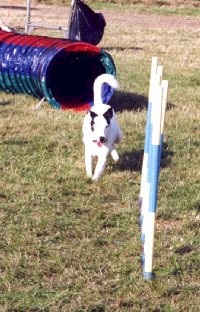 Mary
Ann: Have you invented a special sign language for Merlin? How sensitive is he to
facial expressions? Does Merlin have a sign for his name? Mary
Ann: Have you invented a special sign language for Merlin? How sensitive is he to
facial expressions? Does Merlin have a sign for his name?
Lisanne:
When I got Merlin, I wrote a list of hand signals I was going to use. This helped me to be
consistent in signing and to anticipate problems before they occurred. I reckon he understands
as many hand signals as other dogs understand verbal commands. All dogs like to make their
owners smile.
Some signs I use include a thumbs up or clapping for
'good,' fingers to lips for 'watch' and putting my fists together and twisting them in opposite
directions for 'I'm going to wring your neck!' I don't have a sign for his name. Matching my
signing to my body language is not always easy, but then I find it difficult to match my verbal
commands to my body language with my hearing dogs! We've all at some stage said 'tyre' as we've
run towards the tunnel.
Ambiguity can be a problem for the hearing dog just as
for the deaf dog. I've taught Merlin to follow my hand or to look where I point - not easy to
be exact when you are running! Merlin works out in front of me and, if I am not exactly in the
right spot, facing the right way and pointing in the right (correct) direction, I'll
inadvertently send Merlin the wrong way. One thing that I really worried about was how Merlin
would react to the judge's hand signals to his scribe. Fortunately, he has always ignored them
unless the judge has clapped after a good, clear round!
Mary Ann: I once coached
a young, deaf girl in gymnastics and would always put the cassette player on the ground so she
could feel the music's vibrations for her floor exercise and keep in time to the beat. Do you
think Merlin feels vibrations and have you made use of this in training?
Lisanne:
I tend to use clapping to show Merlin I'm pleased with him. I clap him through the weaves not
because it causes vibration in the air, but because it is a more sustainable sign for a long
set of weaves than a prolonged 'thumbs up.' Also, if I have been running at full pelt and slow
suddenly at a box, Merlin is likely to knock a pole. He may be picking up a changed rhythm in
my foot falls from the ground. I've watched this happen to hearing dogs. It is not the noise of
stamping feet or slapping equipment that attracts Merlin's attention so it must be vibration.
Mary Ann: There are many
challenges that face handlers and their dogs when they are in the ring. How are they different
for you and Merlin?
Lisanne:
There are advantages and disadvantages to working a deaf dog. Merlin will never be distracted
by the handler playing with a squeaky toy in the queue. On the other hand, I have to walk the
course very carefully to ensure that Merlin can see me. I have to meet him a tunnel exits, and
once he lost me on a course because a judge obscured me from him. But basically, my
expectations for Merlin are the same as they are for my hearing dogs. He's deaf, not dumb!
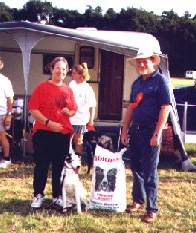
Mary Ann: What is the
secret of your success?
Lisanne:
I don't think he has a sixth sense, but I do think he has certainly become adept at reading me
and predicting my actions. I have certainly had to work hard to read him, and now we are
becoming a team. Merlin seems to understand that there is a right and a wrong way to work a
course, and he wants to do it the right way. Merlin always goes to sleep with part of him
touching me. It's as if he's afraid of waking up and finding me not there. Who's he kidding -
I'd be lost without him. That's the secret to my success.
Mary Ann: Thank you.
That's remarkable story.
For more information about training deaf dogs, see
Deaf Dog Roundtable
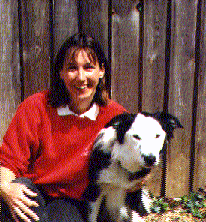 About
the author... About
the author...
Mary Ann Nester is a member of APDT. Born in
the USA, she came to Britain in 1972 as a student. She has pursued a mixed career - fruit
picker, gymnastic coach, keep-fit instructor and academic librarian. In 1997 she set up Aslan
Enterprises, a dog-training school named after her first agility dog.
Running Aslan, a lurcher dog, at agility
competitions got Mary Ann hooked on the sport and Bounty, a German Shepherd Dog, and Tam, the
Border Collie were soon added to the household.
Mary Ann's most successful dog to date has been Brillo
Pad, a Miniature Poodle who took her to Olympia and Crufts. Brillo also competed in the Draw
Challenge on National Lottery Live!, winning Mary Ann the privilege of pushing the button that
released the evening's lottery balls in front of millions of television viewers.
Daz, another miniature poodle and most recent addition,
was bought for competition in the Mini ring, cut grew too tall! He has proved that size doesn't
matter. He entertained the crowds at Olympia as one of the 'fun dogs' and has strut his stuff
in the ABC competition (Any Breed but Collie) at Crufts.
|